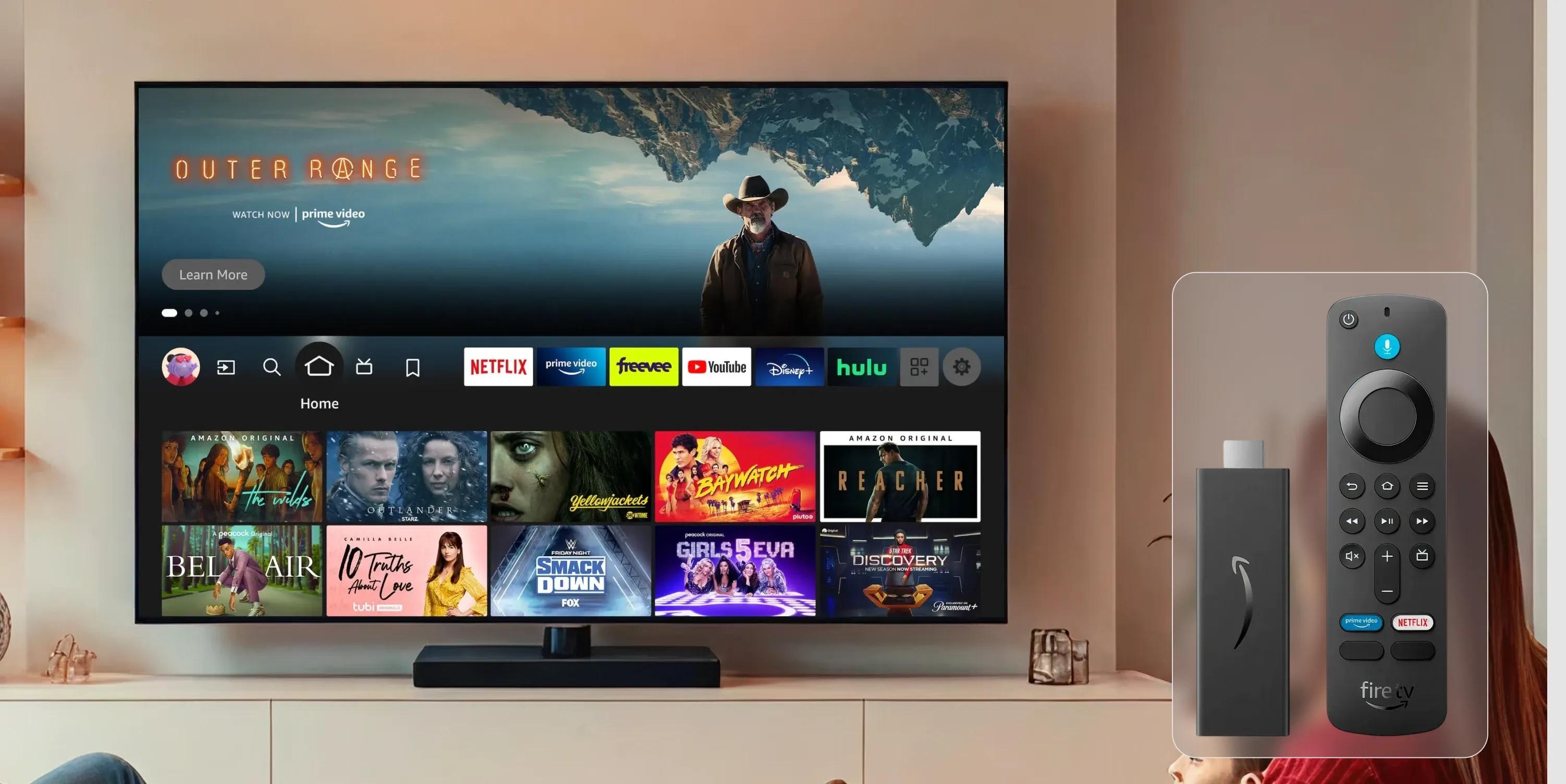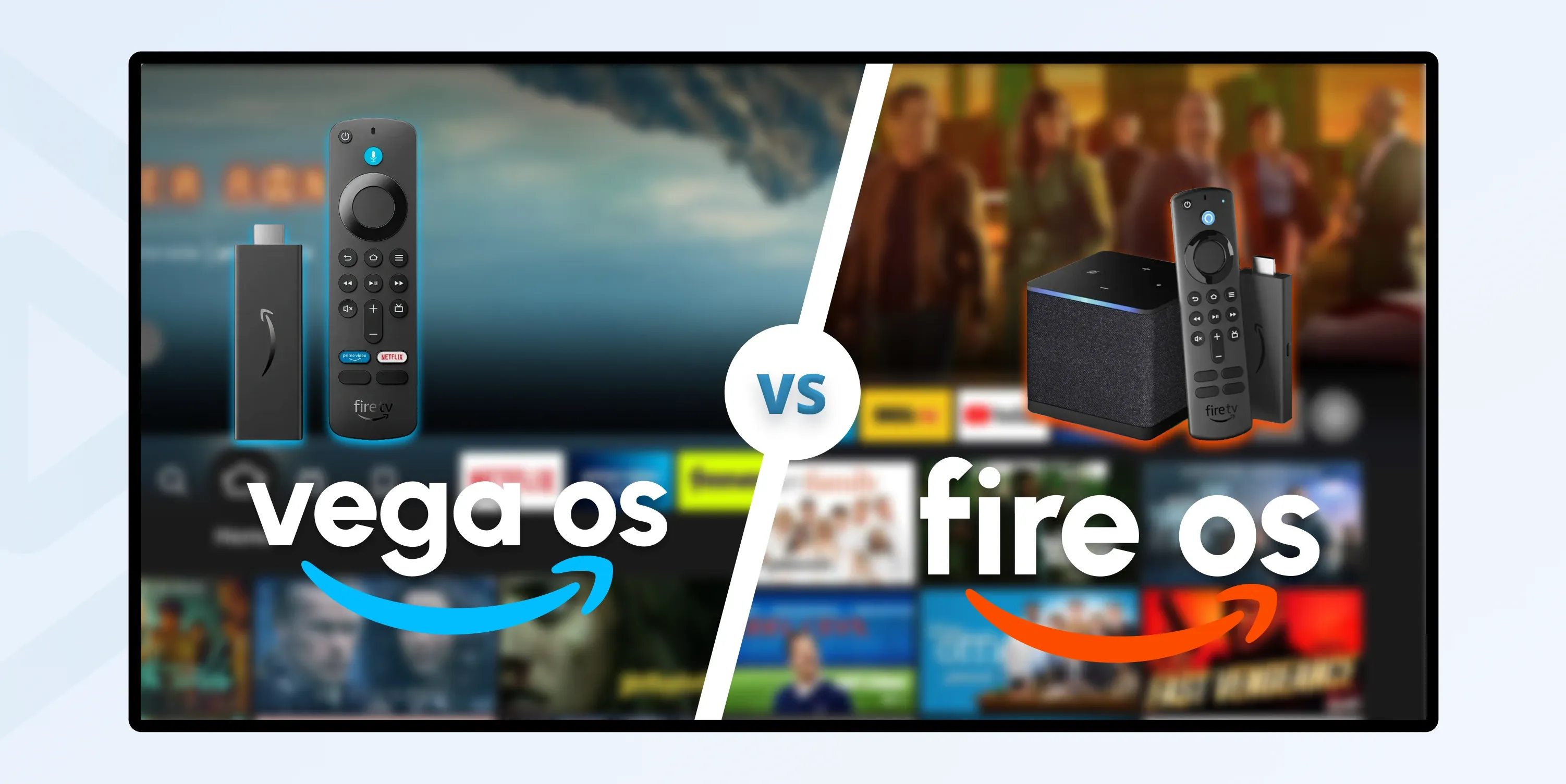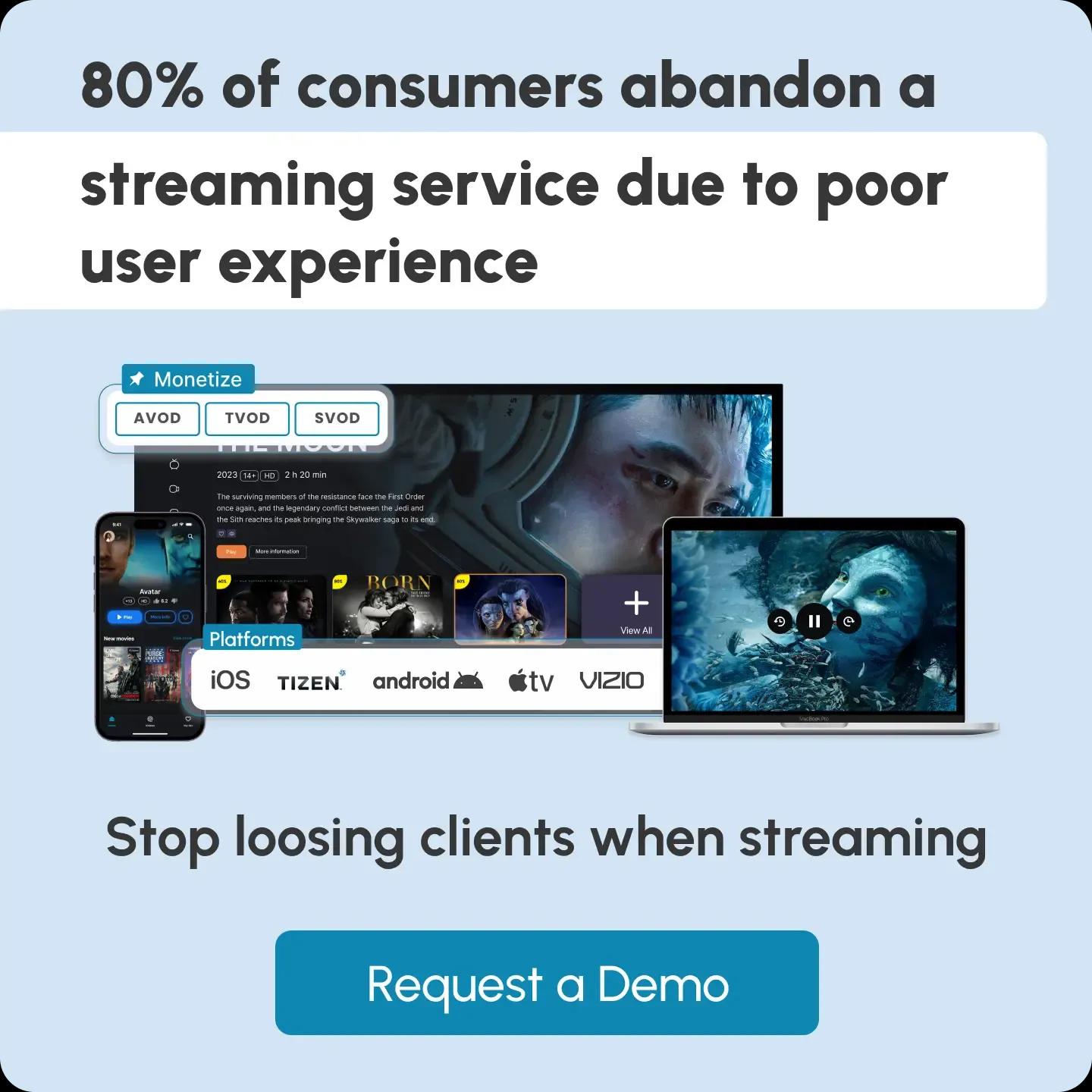
Why Amazon Switches Fire TV to Vega OS? A New Era Beyond Android
A whole ecosystem doesn't shift overnight, so Amazon's move to Vega OS has been years in the making. The company has refined, tested, and optimized every detail to gain complete control of its own operating system since 2023.
That's the essence of this transition: Vega OS is Amazon's own, purpose-built operating system, no longer tied to Android.
But what does this really mean for Fire TV users? And what does this mean for developers building streaming apps?
Let's break it down.
Why Amazon Moves to Vega OS?
Frankly speaking, the shift from Fire OS to Vega OS is Amazon's major strategic and technical upgrade for its entire device ecosystem.
Here are three main benefits that Amazon gets from this transition.
1. Independence from Android
Fire OS was built on Google's Android Open Source Project, limiting Amazon's control over updates and features. Vega OS, built on Linux, removes that dependency, allowing Amazon to design, update, and secure its system without relying on Google's ecosystem or licensing rules.
2. Unified and Optimized Ecosystem
Vega OS enables a single software foundation across Fire TV, smart TVs, and Echo devices. This means faster updates, consistent user interfaces, and smoother cross-device integration. Yes, all these are something harder to achieve under Android's fragmented structure.
3. Performance and Efficiency
Built natively for Amazon hardware, Vega OS uses fewer system resources and loads apps faster. It's optimized for low-memory devices and supports AI-powered features like Alexa Plus without Android's overhead, delivering a faster and more responsive experience for both users and developers.
What Is Vega OS?
Vega OS is a Linux-based operating system developed by Amazon to power Fire TVs, smart TVs, and streaming devices. Unlike the previous Fire OS, which was a customized version of Android, Vega OS is built entirely in-house by Amazon.
The first reports about Amazon Vega OS surfaced in late 2023, when tech outlets and developer community leaks suggested that Amazon was building a non-Android operating system for future Fire TV devices.
The project, internally codenamed "Vega," was initially discovered through job listings, firmware traces, and developer documentation references that hinted at a Linux-based replacement for Fire OS.
Amazon officially confirmed Vega OS in September 2025 through its developer blog and press briefings, announcing it as the new foundation for Fire TV devices. It includes the Fire TV Stick 4K (2024 and 2025 editions) and is extended to future smart TVs.
Vega OS vs Fire OS (Android-based)

Fire OS extended Android for Amazon's ecosystem but came with dependencies and performance limitations.
Vega OS is meant to be Amazon's own lightweight, Linux-based system, built for efficiency, faster updates, and modern app development using web and React Native frameworks rather than Android's SDK.
So, Vega OS is Amazon's next winning move.
Here are both operating systems compared based on core features and functionality.
| Feature | Fire OS (Android-based) | Vega OS (Linux-based) |
|---|---|---|
| Foundation | Built on the Android Open Source Project (AOSP), using Google's mobile framework as its base. | Built on a custom Linux kernel developed entirely by Amazon, independent of Google or Android. |
| App Framework | Uses the Android SDK, supporting apps written in Java or Kotlin. | Uses the Vega SDK, supporting apps built with React Native or web technologies (HTML, CSS, JS). |
| Performance | Carries Android's background services and system overhead, which can affect speed on lower-end devices. | Optimized for lightweight performance and faster app loading, even on devices with 1 GB RAM. |
| Ecosystem Control | Dependent on Android's structure and update cycles, limited flexibility in customization. | Fully controlled by Amazon, allowing faster updates, custom features, and unified software behavior across devices. |
| App Compatibility | Compatible with most Android apps and supports sideloading. | Not directly compatible with Android apps; developers must port or rebuild using the Vega SDK. |
| Security Model | Inherits Android's permission and security layers, including APK installation. | Employs a closed app environment with installations restricted to the Amazon Appstore, improving consistency and security. |
| Developer Tools | Built around Android Studio and Fire Device Bridge. | Uses the Vega CLI, Simulator, and VS Code extensions for testing and debugging. |
| User Interface | Follows a Fire TV skin layered over Android UI elements. | Features a redesigned interface built natively for Vega OS with faster transitions and better voice integration. |
Who Is Affected by This Transition?
The switch from Fire OS to Vega OS also impacts everyone in Amazon's ecosystem: users, developers, and Amazon itself.
While users will notice faster performance and a smarter interface, developers will face the biggest changes as they adapt their apps to a completely new environment.
The Change for Developers
Since Vega OS uses its own framework, the old Android SDK is no longer compatible.
Amazon introduced the new Vega SDK to match the needs of its latest operating system, which is no longer based on Android. It gives developers the tools to build, test, and update apps that work natively on the new system, while also making development faster and more accessible.
With Vega SDK, developers can create apps using React Native or web technologies such as HTML, CSS, and JavaScript. So there's no required need for Android-specific knowledge.
It works with the Vega Simulator and Visual Studio Code, making testing and deployment easier.
Since the system is no longer tied to Android, developers can expect more consistent behavior across Fire TV devices, with fewer compatibility issues between models.
And what about the existing apps running on Fire OS?
Because Vega OS uses a different framework, developers need to adapt their existing apps to maintain compatibility. Amazon provides migration guides and developer tools to support this process.
Once updated, apps will be managed through the Amazon Appstore without depending on Android's release schedule.
Therefore, existing Fire TV apps built for Fire OS must be updated or rebuilt for Vega OS; however, Amazon currently still allows multi-OS use.
What's New for Users?
From a user's perspective, as we already mentioned, Vega OS introduces noticeable speed improvements, a cleaner design, and more intelligent navigation powered by Alexa Plus.
The interface responds faster, apps open more quickly, and users can interact with content using natural voice commands rather than simple instructions. Simply put, a win-win situation.
But will sideloading still be possible?
Sadly, no. Users will only be able to install applications through the Amazon Appstore. Although this move limits flexibility for users who previously installed third-party apps via APK files, it strengthens system security, which is the primary concern.
What It Means for the OTT and Streaming Industry
The introduction of Vega OS has direct implications for the OTT and streaming industry. It affects how streaming platforms deliver and optimize their apps on Fire TV, one of the most widely used connected TV ecosystems worldwide.
For OTT providers, Vega OS means tighter integration with Amazon's hardware and software environment. Apps built or adapted for Vega can take advantage of faster load times, smoother playback, and better resource management, which are crucial for streaming high-quality video.
The change also opens the door for deeper use of Alexa Plus and AI-driven personalization. Streaming platforms can create experiences that respond to natural voice commands, surface context-aware recommendations, or use viewer data to improve engagement.
However, the removal of sideloading and Android app support means OTT services must work more closely with Amazon's Appstore approval and update process.
In the long term, Vega OS could strengthen Amazon's position as both a platform provider and a competitor in the streaming industry.
Will Vega OS Benefit Everyone In The Amazon Ecosystem?
Vega OS will be highly beneficial for everyone within the ecosystem.
It'll provide a faster, smarter Fire TV experience with smoother performance and quicker responses for users.
The new Vega SDK will enable developers to build and update apps more efficiently across Amazon devices.
This will also let Amazon deliver updates and new features directly, keeping the entire ecosystem more secure and connected.
Thanks to Vega OS, Amazon
- Is no longer dependent on Google (no Android framework or Google services).
- Has full control over updates, performance, and app integration.
- Gets optimized media playback, voice interaction, and AI-driven experiences through Alexa.
- Aligns Fire TV devices, TVs, and other Amazon smart home products under a single software ecosystem, similar to what Apple does with tvOS and iOS.
- Uses a new Amazon Appstore framework optimized for Fire TV devices, though it maintains backward compatibility with major streaming apps.
For the industry, Amazon's move signals two major changes:
1. The rise of custom, brand-owned OS ecosystems (like Samsung Tizen, LG webOS, Roku OS).
2. The next era of AI-assisted, voice-first streaming experiences.
In the end, Vega OS marks a turning point for Amazon, giving the company full ownership of its software ecosystem and the freedom to innovate beyond Android. It sets the foundation for faster updates, deeper AI integration through Alexa, and a unified experience across every Amazon device.
Frequently Asked Questions
Product Owner
Andranik is a Product Owner specializing in OTT, IPTV, and FAST technologies at inoRain. He leads the development of scalable, end-to-end streaming solutions that enhance video delivery and monetization. His work bridges technical innovation with real business impact, helping platforms and the hospitality sector optimize performance, user experience, and operational efficiency.

How to Make a Short Video App (2026 Complete Guide)
Learn how to build a short video app in 2026. Explore micro-drama trends, key features, monetization models, and step-by-step development insights.

OTT Advertising: Types, Best Practices, and Strategies
Over-the-top (OTT) advertising has transformed how brands connect with consumers.

Video Streaming Protocols: Types and Use Cases
Learn about video streaming protocols, how they work, key factors to consider, and the challenges involved in choosing the right protocol.

